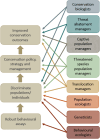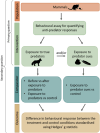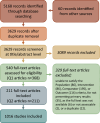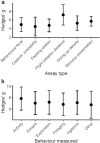Identifying the most effective behavioural assays and predator cues for quantifying anti-predator responses in mammals: a systematic review
- PMID: 39294799
- PMCID: PMC11378833
- DOI: 10.1186/s13750-023-00299-x
Identifying the most effective behavioural assays and predator cues for quantifying anti-predator responses in mammals: a systematic review
Abstract
Background: Mammals, globally, are facing population declines. Protecting and breeding threatened populations inside predator-free havens and translocating them back to the wild is commonly viewed as a solution. These approaches can expose predator-naïve animals to predators they have never encountered and as a result, many conservation projects have failed due to the predation of individuals that lacked appropriate anti-predator responses. Hence, robust ways to measure anti-predator responses are urgently needed to help identify naïve populations at risk, to select appropriate animals for translocation, and to monitor managed populations for changes in anti-predator traits. Here, we undertake a systematic review that collates existing behavioural assays of anti-predator responses and identifies assay types and predator cues that provoke the greatest behavioural responses.
Methods: We retrieved articles from academic bibliographic databases and grey literature sources (such as government and conservation management reports), using a Boolean search string. Each article was screened against eligibility criteria determined using the PICO (Population-Intervention-Comparator-Outcome) framework. Using data extracted from each article, we mapped all known behavioural assays for quantifying anti-predator responses in mammals and examined the context in which each assay has been implemented (e.g., species tested, predator cue characteristics). Finally, with mixed effects modelling, we determined which of these assays and predator cue types elicit the greatest behavioural responses based on standardised difference in response between treatment and control groups.
Review findings: We reviewed 5168 articles, 211 of which were eligible, constituting 1016 studies on 126 mammal species, a quarter of which are threatened by invasive species. We identified six major types of behavioural assays: behavioural focals, capture probability, feeding station, flight initiation distance, giving-up density, and stimulus presentations. Across studies, there were five primary behaviours measured: activity, escape, exploration, foraging, and vigilance. These behaviours yielded similar effect sizes across studies. With regard to study design, however, studies that used natural olfactory cues tended to report larger effect sizes than those that used artificial cues. Effect sizes were larger in studies that analysed sexes individually, rather than combining males and females. Studies that used 'blank' control treatments (the absence of a stimulus) rather than a treatment with a control stimulus had higher effect sizes. Although many studies involved repeat measures of known individuals, only 15.4% of these used their data to calculate measures of individual repeatability.
Conclusions: Our review highlights important aspects of experimental design and reporting that should be considered. Where possible, studies of anti-predator behaviour should use appropriate control treatments, analyse males and females separately, and choose organic predator cues. Studies should also look to report the individual repeatability of behavioural traits, and to correctly identify measures of uncertainty (error bars). The review highlights robust methodology, reveals promising techniques on which to focus future assay development, and collates relevant information for conservation managers.
Keywords: Anti-predator behaviour; Behavioural adaptation; Behavioural assay; Effect size; Evidence synthesis; Predator avoidance; Predator cue; Prey naïveté.
© 2023. The Author(s).
Conflict of interest statement
The authors declare that they have no competing interests.
Figures







Similar articles
-
Sustained predation pressure may prevent the loss of anti-predator traits from havened populations.Ecol Evol. 2024 Jul 10;14(7):e11668. doi: 10.1002/ece3.11668. eCollection 2024 Jul. Ecol Evol. 2024. PMID: 38988349 Free PMC article.
-
Small class sizes for improving student achievement in primary and secondary schools: a systematic review.Campbell Syst Rev. 2018 Oct 11;14(1):1-107. doi: 10.4073/csr.2018.10. eCollection 2018. Campbell Syst Rev. 2018. PMID: 37131395 Free PMC article.
-
Behavioural modification interventions for medically unexplained symptoms in primary care: systematic reviews and economic evaluation.Health Technol Assess. 2020 Sep;24(46):1-490. doi: 10.3310/hta24460. Health Technol Assess. 2020. PMID: 32975190 Free PMC article.
-
Native and invasive squirrels show different behavioural responses to scent of a shared native predator.R Soc Open Sci. 2020 Feb 26;7(2):191841. doi: 10.1098/rsos.191841. eCollection 2020 Feb. R Soc Open Sci. 2020. PMID: 32257340 Free PMC article.
-
Naïveté in novel ecological interactions: lessons from theory and experimental evidence.Biol Rev Camb Philos Soc. 2014 Nov;89(4):932-49. doi: 10.1111/brv.12087. Epub 2014 Feb 7. Biol Rev Camb Philos Soc. 2014. PMID: 25319946 Review.
Cited by
-
A systematic review protocol for quantifying bycatch of critically endangered leatherback sea turtles within the Pacific Ocean basin.Environ Evid. 2024 Nov 29;13(1):27. doi: 10.1186/s13750-024-00352-3. Environ Evid. 2024. PMID: 39614399 Free PMC article. Review.
-
Balancing act: persistence of the red fox in the dog-dominated landscapes of the Trans-Himalaya.Proc Biol Sci. 2025 Jun;292(2048):20250333. doi: 10.1098/rspb.2025.0333. Epub 2025 Jun 4. Proc Biol Sci. 2025. PMID: 40461076 Free PMC article.
-
A Sting Operation: Risk Assessment and Venom Expenditure by Arizona Bark Scorpions (Centruroides sculpturatus) in a Defensive Context.Toxins (Basel). 2025 Apr 13;17(4):198. doi: 10.3390/toxins17040198. Toxins (Basel). 2025. PMID: 40278696 Free PMC article.
-
Large mammal behavioral defenses induced by the cues of human predation.PNAS Nexus. 2024 Sep 3;3(9):pgae382. doi: 10.1093/pnasnexus/pgae382. eCollection 2024 Sep. PNAS Nexus. 2024. PMID: 39282006 Free PMC article. Review.
References
-
- Ceballos G, Ehrlich PR. Mammal population losses and the extinction crisis. Science. 2002;296(5569):904–7. - PubMed
-
- Schipper J, Chanson JS, Chiozza F, Cox NA, Hoffmann M, Katariya V, et al. The status of the world’s land and marine mammals: diversity, threat, and knowledge. Science. 2008;322(5899):225. - PubMed
-
- Spooner FEB, Pearson RG, Freeman R. Rapid warming is associated with population decline among terrestrial birds and mammals globally. Glob Change Biol. 2018;24(10):4521–31. - PubMed
-
- Newbold T, Hudson LN, Hill SLL, Contu S, Lysenko I, Senior RA, et al. Global effects of land use on local terrestrial biodiversity. Nature. 2015;520(7545):45–50. - PubMed
-
- Ross AK, Letnic M, Blumstein DT, Moseby KE. Reversing the effects of evolutionary prey naiveté through controlled predator exposure. J Appl Ecol. 2019;56(7):1761–9.
Publication types
Grants and funding
LinkOut - more resources
Full Text Sources
